Overview

Personal Project
Afterthought


PC

2

6 months
Tasks & Responsibilities
-
Technical Game Design
-
AI Behavior
-
Sound & UI Design
-
-
General Game Design
-
Player Loadouts & Skills
-
Documentation & Project Management
-
Overall Game Balance & Quality Assurance
-
-
Level Design
-
Floor Planning
-
Designed 4 maps, using modular assets & props
-
-
Storytelling & Character Backstory
-
Video Editing & Cinematics
Afterthought - Gameplay Trailer
Afterthought is a Single player FPS, with RPG elements and was developed by a team of 2, during my second to last semester at SAE Athens Institute. The players unveil the story of the game, by exploring and fighting their way against respective enemies on 4 different linear maps.
The game was developed in Unity Engine for PC platforms within 6 months. In terms of gameplay mechanics, other than combat systems, players can level up their character, choose between different talents and unlock different kinds of weapons.
Furthermore, this project has been a nominee in "The Rookies Awards 2021", as "Game of the Year - Console & PC", as well as a nominee in "SAE Awards 2021", as "Best Games Programming Project".
Technical Game Design
AI Behavior
Other than the player attributes and movement, Afterthought was really focused on AI behavior and combat mechanics. I implemented various states for enemy behavior, such as attack, patrolling, chasing, shooting and taking cover. It was my first complex AI system, that apparently reacts dynamically to the player's actions and the environment. On top of that, I created different types of enemies, including light, medium and heavy, that have distinct behaviors, which added depth to the encounters.
Furthermore, players have companions in the levels who assist them in taking down enemies. These companions share the same race as the players (Cyborgs and Humans), which makes battles feel more immersive.
Overall, each of the AI characters had their own attributes, such as health, damage output and collision mechanics, which created challenging but fair gameplay experiences. On top of each character, animations played a vital role in enchanting immersion and every character had their own unique ones. From running and walking to idle and patrolling, as well as ragdoll death animations, each one contributes to the overall feel of the game and provides visual feedback to the players.

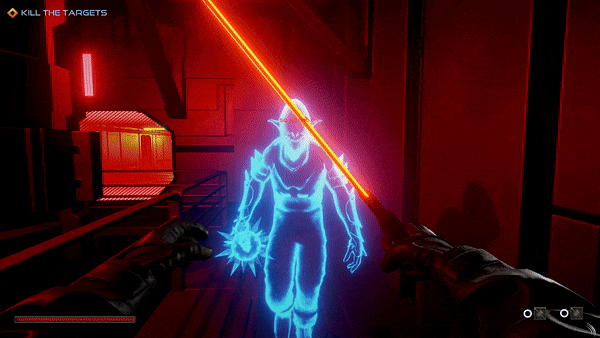
(1) A melee enemy is attacking the player - (2) The player is attacking a melee enemy
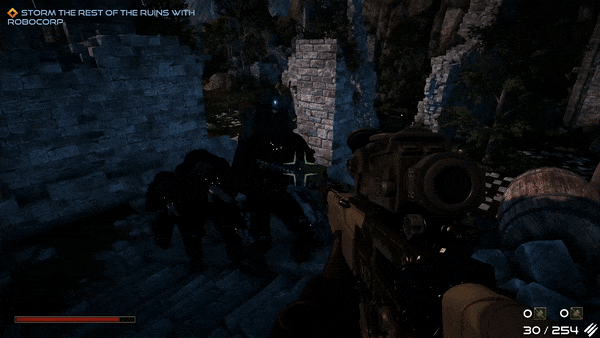

(1) Companion AI is advancing in front of the player - (2) Companions are fighting against the enemies
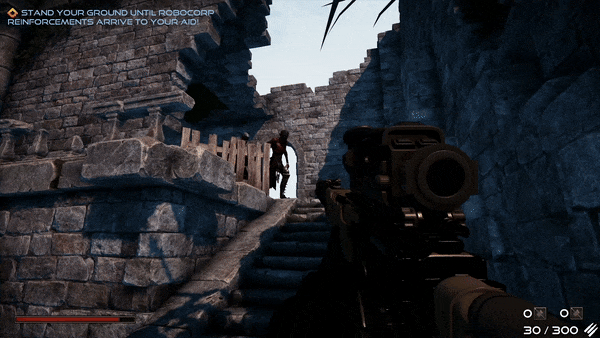
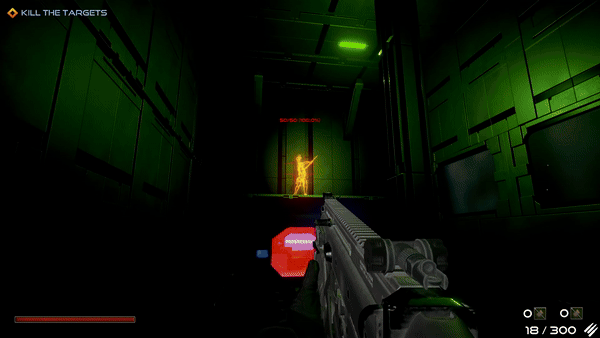
(1) Ragdoll death animation - (2) Ranged enemy is attacking the player
Sound & UI Design
The attention to sound and UI design of Afterthought add significant depth and immersion to the game, as well as assist users in a better user experience. To start off, I developed a system for each surface the players and on companions were stepping on, which generated different SFX according to terrain types. This design added environmental believability and provided auditory cues for players. Furthermore, another sound design I implemented, was different bullet impacts based on the surface each bullet was registered. This also enhances combat feedback and adds another layer of depth to the sound system of the game. Each weapon also has unique sound effects that reflect its characteristics and firepower.
Other than the gameplay elements, for the UI feedback sounds, I implemented different clicks and hover sounds to reinforce player interactions in each element. Lastly, at the start of the game, background royalty free music sets the mood for the game, while another implementation of different gameplay moments was completing the game's visuals and narrative elements. By mixing different music backgrounds depending on the moments players were experiencing, like the tense atmosphere of combat or the ambiance of exploration, the chosen tracks were also simulating what to do next.
With a total of 17 weapons and their crosshairs, 8 gadgets and various bullet types available to the players, I created different UI elements to convey information quickly and efficiently. Each icon represents its respective item in a visually distinct and recognizable manner, aiding players' decision-making during gameplay. As for the talents, due to time constraints, I used RPG UI elements that matched the aesthetic of the game, from the Unity asset store to convey their effects, alongside with tooltips, as players were hovering on them.
On top of the above UI elements, I created the players' health bar, as well as every objective system UI, which provided clear feedback to make strategic decisions accordingly and progress to current tasks. In the later stages of the game, I also created the logo of the game, that combines the futuristic and medieval elements accordingly.











Example of UI elements used for some of the weapons and gadgets




Example of different crosshairs for each weapon type

Main Menu Overview
General Game Design
Player Loadouts & Skills
One of our main priorities for this game was to combine RPG-like elements with the FPS genre, as well as replayability for each map. As mentioned, players can choose from a variety of 17 weapons, each with their own unique characteristics, such as damage output, rate of fire, accuracy, range, reload speed etc. This diverse selection allows players to tailor their loadout to suit their preferred playstyle, from close-quarters combat to long-range engagements.
On top of the weapons, players had 8 different gadgets that offered them utility and tactical advantages over the enemies. These gadgets include different types of grenades, mines and tactical drones that serve as companions. Furthermore, I designed a skill system (talents), which allowed players to further customize their loadout by investing XP points into their upgrades. These talents enhance weapon efficiencies, improve survivability, unlock special maneuvers, like double-jumps or dashes, which allow players to revisit hidden or locked areas on the 1st run.
Mixing the above together, even though Afterthought has a linear level design approach, by exploring, looting and upgrading the character, my design aimed to add replayability and another depth of immersion into the world of the game.


(1) Player Loadout inspector script overview - (2) Example of a weapon data & stats overview

In-game Player Loadout Editor
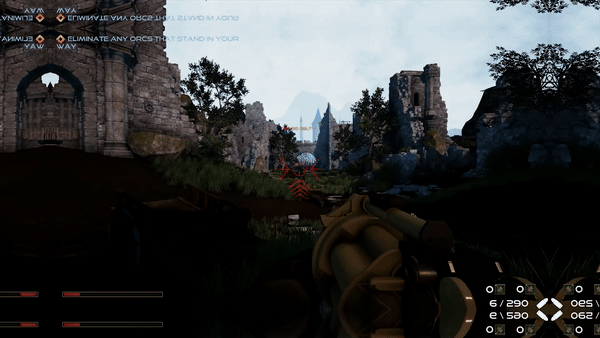

(1) Grenade Launcher shot and impact - (2) Crossbow shot and reload animation
Documentation & Project Management
Even though Afterthought was developed by two people, effective documentation and project management was vital for ensuring the successful development of the game. I designed the GDD, which serves as the blueprint for the game, detailing the concept, the gameplay mechanics, features and the overall vision of the team. It also outlined the AI behavior, the player loadout system, the sound and UI design, as well as the level design and the narrative of the game. Due to time constraints, as a team we had to make sure that we were successful for each milestone and I maintained the overall documentation to keep on track.
Furthermore, regular team meetings were taking place 2-3 times per week to discuss progress, brainstorm ideas, assign tasks and address any issues or concerns. I kept meeting logs to document the discussions and the decisions made by all team members, in order to ensure both of us were aligned and accountable for our responsibilities.
As a project management tool, we used Trello boards to organize tasks, track progress and collaborate with each other. We broke down the development process into tasks, such as programming, art assets, sound design, UI implementation, testing and bug fixing, as well as we tracking through different stages (e.g., to-do, in progress etc.)
Overall, to develop Afterthought, we used agile methodologies to facilitate iterative development cycles and adapt to changing requirements. This allowed us to have flexibility and fast responsiveness, while we maintained a steady pace of development, to successfully reach certain milestones.
Overall Game Balance & Quality Assurance
Maintaining the overall game balance was also acritical aspect of the game development of Afterthought. As a, team we carefully balanced various attributes and gameplay mechanics to ensure fair and enjoyable gameplay. This includes parameters such as enemy and player health, damage output, weapon stats, enemy and companion behavior, player's talents, difficulty curves, XP allocation etc. Speaking of XP allocation, the game's progression curve was iterated a lot to provide a smooth and engaging experience, as players advance through levels and upgrade their character.
As the game also included resource management elements, such as ammo and health pickups, balancing the economy was also crucial. This involved determining the rate of resource acquisition, the cost of obtaining weapons and talents through the XP system and the impact of resource scarcity on the maps.
We also conducted bug testing throughout the development process, to help identify and address technical issues, glitches and game-breaking bugs. This included functional testing from the team, but also playtesting from individuals outside the development team, to provide feedback on gameplay mechanics, level design, difficulty balance and overall gameplay. Lastly, we managed to run through various performance optimizations including addressing bottlenecks and refactoring in code, resource and texture usages, but we also implemented efficient rendering techniques, like occlusion culling and light baking, to maintain consistent frame rates for different hardware.
Level Design
On top of the above responsibilities, another main task for this project was to level design the environments of the game, to complement the game's narrative, mechanics and overall game experience. Leveraging modular assets for the Unity Asset Store, I designed four levels, each with its own unique challenges and purposes. From the introductory training level to a testing boss fight arena, every map was created to provide players with an enjoyable gameplay experience.
Starting off with the Training Level, I designed a map which introduces players to the game's mechanics, controls and enemy encounters. This level features guided gameplay segments with on-screen prompts to teach players how to navigate, how to use their loadout, how to engage in combat and how to earn XP.

Training level as seen in the loading screen of Afterthought
Another map I designed was the Main Hub area for players to access different levels, manage their loadout and progress through the game. This map was non-linear and featured different portals to interact with. This central area belongs to the Cyborgs (same race as the player) and provides them with interactions with NPC companions, a testing range and a shop where they can plan their next move and upgrade their character.

Main Hub as seen in the loading screen of Afterthought
Battle of Ruins presents players with the main challenging combat scenario in a linear castle environment, filled with Orcs. This level features scripted events, varied enemy encounters, like waves, and the use of companions in favor of the player. On top of that, I designed some locked areas which can be unlocked after certain playthroughs or acquire specific talents in order to reach them.

Battle of Ruins as seen in the loading screen of Afterthought
Due to some iterations we did for the "Boss Fights" implementation, I also created an arena style level, which offered an optional challenge to players and stayed hidden within the Main Hub. In the final build of the game, we decided to include it to collect more feedback for this feature as well.
A pack of in-game images for game showcase
Through careful planning and attention to detail, I aimed to create levels that not only served as backdrops for gameplay but also enriched the overall narrative and player experience. By seamlessly integrating modular assets, I ensured efficiency and visual fidelity, resulting in a polished and immersive gaming experience.




